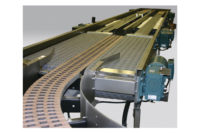
Conveyors are no strangers to the challenges of beverage production. Increasing production speeds, handling the growing number of SKUs and packaging varieties, and decreasing energy costs are all impacting conveyors too.
In addition, conveyors are expected to be safe, reliable and maintenance free, all in as little space as possible. And as the industry’s demands advance, so does this essential middle man’s responsibilities.
A strong piece of conveyor equipment is manufactured to meet demands such as installation requirements, operation necessities and maintenance needs, says Pat Vincent, president and chief operation officer at Arrowhead Systems Inc., Oshkosh, Wis., a company that offers equipment including air, open-top, closed-top, case and pallet conveyors. Questions to consider when comparing conveyor equipment are: Is the conveyor flimsy? Can it be moved around and placed in position without twisting and bending? When considering the operations, is the conveyor designed for worse-case scenario, especially for customers running multiple containers? Can the equipment be maintained without needing to take it apart?
In addition to these requirements, beverage companies are demanding “higher speeds, more reliability and less maintenance” from conveying equipment, says Ole Rygh, president of Ryson International Inc., Yorktown, Va.
“We’re seeing that the customers are looking for equipment that is easy to maintain,” he says. “The trend that we are seeing is that these corporations are cutting down on their maintenance staff. Very often they have outside people maintaining it. If it isn’t easy to maintain, than it’s just not being maintained.”
A provider of pallet conveyors, Wulftec International Inc., Ayer’s Cliff, Quebec, sees customers requiring heavy-duty construction, especially for pallet conveyors, which need to resist impact.
“Sometimes they can be impacted when people are loading, either with a forklift or dropping pallets on a conveyor, so they need it to be built really strong,” says Priscille Tremblay, sales manager for Wulftec. “Some of the things that you need to look for in a strong conveyor are the thickness of the conveyor frame; the thickness of a roller. Then there is also the size of the chain, the size of the roller shaft and the bearings.”
The strength and position of the drive systems is also a consideration. “It’s better to have a motor system that’s located in the center of the conveyor, because this ensures good bidirectional operation,” Tremblay says.
Capable conveyors
To manage the demands of production, conveyors must provide the right amount of accumulation between machines to maximize line efficiency, says Stephane Banville, general manager of Sidel Inc., Norcross, Ga.
“Some of the trends on conveyors that we have seen over the last few years are more compact conveyor designs that require less floor space to provide the same amount of accumulation as classic mass flow conveyors,” Banville says. An example of a more compact design is Sidel’s AQmax accumulation table, which uses nearly all of its surface for accumulation of plastic, glass and aluminum packages in a trim space, he says.
Ryson, which manufactures spiral conveyors, also hears beverage companies asking for help in conserving space. “We made spirals that have a very small diameter, which will save space,” Rygh says. “We see that the packaging lines are faster, and they take more space and the buildings are the same. So we are working on conveyors that take less space that can operate faster.”
Beverage companies also are looking to maximize their conveyor equipment by setting up lines to be more flexible. “Conveyors in particular need to handle a multitude of container sizes and shapes,” Arrowhead’s Vincent says.
“The bottom line in better production numbers is the original layout of the equipment and conveyors,” he continues. “An efficient layout will optimize each machine in the line by accommodating the right length and style of conveyors. But ultimately, it is the conveyor/system controls that will make or break those efficiency goals.”
Getting beverage packaging from point A to point B is a continual improvement process for conveyor manufacturers. “It seems that more and more of our customers are seeing the performance benefits of container accumulation in their production lines,” says Dave Rynders, layout department manager, product manager – conveying technology for KHS USA Inc., Waukesha, Wis. “Line efficiencies of 70 percent or 80 percent are no longer acceptable. With the proper accumulation times designed into a production line, line efficiencies of 90 percent are easily attainable.”
Conveyors also are becoming “smarter,” which amounts to cost savings, says Boyce Bonham, manager of quality assurance at Hytrol Conveyor Co. Inc., Jonesboro, Ark. Hytrol offers EZLogic Gen 3, a control that’s mounted along the side of the conveyor to provide intelligence to each zone of the conveyor. EZLogic offers a program that knows that a pallet has been picked up and is being unloaded from the conveyor, so beverage companies don’t have to have external wiring.
Increased technology also offers beverage companies more versatility. For companies handling multiple size pallets on a single line, EZLogic can determine how long the pallet is and assign the correct number of zones to accommodate that, Bonham says. And in regard to interacting with other parts of the line, if a company has areas where products need to merge, EZLogic controls can be set so that one conveyor will stop while the other conveyor releases.
Conveyors also are providing more information that can be taken to feed lines and take-away equipment, Bonham says. “…It’s all done internal to the conveyor, so it saves on installation time, start up time and obviously cuts down on the amount of electrical wiring that has to be done.”
Environmental impact
Saving energy, cutting production costs and environmental concerns also are trends affecting conveyor systems. Hytrol’s EZLogic offers energy savings by controlling zoned accumulation conveying where the zones only operate when pallets are moving on the conveyor. After the pallets move by the zones, that portion of the conveyor shuts down so it’s not using power.
“Its run time is based on the amount of throughput instead of just sitting there and running all the time,” Bonham says. Hytrol also introduced an E-24 DC conveyor that is driven by 24-volt motors in every zone for handling case loads of 12-packs and 24-packs rather than pallets. The E-24 shuts the zone down when its accumulator is asleep. When the zone stops there is no energy being consumed, whereas with previous Hytrol conveyors companies were only saving 30 to 50 percent power usage in sleep mode.
“It can impact the beverage industry tremendously as far as the energy being consumed with that facility,” Bonham says. Lightweighting of bottles offers another environmentally and economically driven trend that is not only impacting packaging equipment but conveyor equipment as the lighter bottles move down the line.
“As PET bottles are getting lighter and lighter, air conveyor design must be more creative and more accurate in order to avoid line downtime,” Sidel’s Banville says. “One solution to increased lightweighting is a Combi option of blowing and filling. Once a PET bottle is full, low-pressure accumulation conveyors and the gentle control of full bottle conveyors, provided by automation specialists, are necessities.”
Beverage companies also have begun to use plastic pallets and reuse pallets to conserve money and resources instead of disposing of the pallets after usage. But as the pallets continue to be reused, their condition worsens. “To ensure smooth operation of these different pallets, the right way to go is to use conveyors with close roller spacing and also with a small roller diameter to reduce the center-to-center distance,” Wulftec’s Tremblay says. “This will ensure smooth operation of any kind of pallets that the customer may use.”
Conveyors continue to evolve by using the latest in modular chains along with purpose-built components to improve product handling. Trends are emerging such as using roller-less case conveyors and automatically adjustable guide rails. “These trends enable the beverage producers to set up a flexible line that can run packages desired by their customers as well as omitting as much secondary packaging as possible to reduce costs and become more environmentally friendly,” Arrowhead’s Vincent says.
A conveying future
As technology advances, so do conveyor systems. “The use of state-of-the-art camera, photo eye and communications technology allows for more sophisticated programming and control systems, pushing existing conveyor philosophies to the edge and allowing engineers to develop new, more efficient methods of controlling conveyor systems and successfully handling the new advanced packaging formats for the consumer markets,” KHS’s Rynders says.
“Conveyor systems are no longer treated as ‘the stuff between the real machines,’” he continues. “Conveyor systems are quickly becoming the ‘life blood’ of the production line. Developing new methods of control and communication between the conveyor systems and the functional pieces of equipment on the line, product lines can run at higher efficiencies, with high line outputs in less time.
“Due to the higher line efficiencies, beverage companies are able to reduce the cost of manufacturing with shorter production runs, lower consumption of utilities, less overhead due to product storage with the ability to produce-to-order.”
Pallet conveyors also are progressing. “There are some trends coming from the automation world in general such as decentralizing the control and the power for the conveyors,” says Guy Lopes, group engineering manager, machines division, at Wulftec. “As an example, mounting remote [Input/Oputs] and mounting the inverter locally with the conveyor is minimizing the quantity of cables going to the conveyor to control it, so making it more independent, more autonomous — each conveyor section one by one.”
Taking a cue from the European approach to conveyor equipment, pallet conveyors also are starting to feature zinc-coating of the rollers. “In Europe, it’s a standard right now,” Lopes says. “In North America it’s not, but we feel that it’s coming more and more, especially for the bottling industry to adapt the wiring methods for basket-type cable trays instead of traditional rigid conduits that were used up to now. In Europe, this is very strong for reasons of stability and cleanliness. With a basket cable tray you can basically wash down easily and there is no hidden space for insects or rodents.
“With all the environmental issues, people want to cut down on cleaning, soaps and quality of liquids used. Everything that we can do to make the cleaning aspect easier and faster, companies look for, and more and more will look for.”



